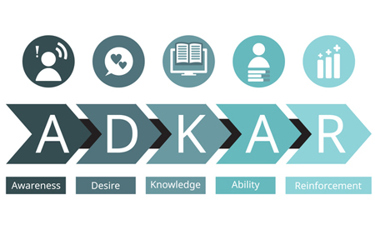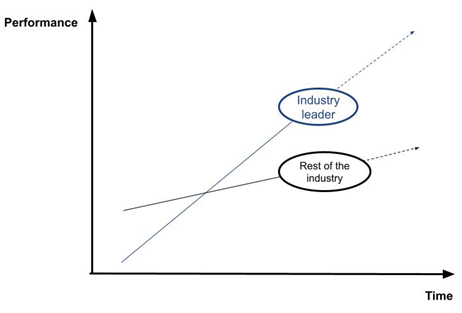Using The ADKAR Model In Biopharma Change Management
By Juan Da Ros

The usual way of thinking is that the deciding factors in terms of an organization’s performance are tools, techniques/methods, and technology. Using this framework, the leading company in a particular sector must be the one using the best tools, techniques/methods, and technology. However, things aren’t so simple. Steven Spear, renowned for his work on Toyota’s manufacturing system, states that organizations dedicated to continuous learning and improvement are the ones that ultimately dominate their market sector, even if they start from a disadvantaged position:1

With this system, Toyota went from having one-eighth the productivity of the world standard in the 1950s to being the leader of its sector in the 1980s, surpassing Ford, GM, and Chrysler.1 2This "catching-up" happens through incremental improvements. One after the other, small changes can transform an average-performing organization into a leader in its sector.1
This highlights why resistance to change is so important: it may be what separates your company, organization, or team from achieving the results you desire.
Where Does Resistance Come From?
We in the biopharma industry tend to be highly technical, well-educated, organized, and well-equipped with numerous tools. However, we often overlook the social aspect of change. It doesn't matter how beneficial the change is or how many SOPs you write if no one is on board with it. Change implementation has both a technical and a social aspect, and the latter cannot be ignored.2
When it comes to communicating change, the person delivering the message and the person receiving it often seem to be speaking different languages. While the emitter of the message is enthusiastic about the change and talks about the business/team benefits of the change, the receiver is more likely to focus on how the change affects him personally. This produces anxiety in the receiver, who is thinking that the sender may not be happy with their performance or that the company/team is having trouble or that he’ll become irrelevant with the new process.3
Let’s analyze it with an example.
Example Of A Challenging Change: From 150 Roller Bottles To One Single-Use Bioreactor
In a small biopharma company, the production of a recombinant protein, erythropoietin (EPO), involves culturing CHO (Chinese hamster ovary) cells using an adherent mammal cell process in 2-L roller bottles. This bioprocess requires monitoring and controlling 150 roller bottles simultaneously for seven days. The process goes from inoculation with the cells to the harvest of the media with the recombinant protein. The in-process controls involve daily macroscopic and microscopic observation of each of the 150 roller bottles until the harvest day. On the harvest day, the liquid from each bottle is transferred to a bioreactor under sterile conditions.
This process is intensive, detail-oriented, and demands exclusive dedication from a single operator, who is responsible for performing all tasks related to the monitoring and control of the roller bottles. Due to the meticulous nature of the observations and the sheer number of roller bottles involved, the operator finds it challenging to complete all observations within a standard workday. The maneuvering of so many units under sterile conditions has also been identified as a critical point of contamination, requiring strict adherence to sterile techniques and thorough monitoring.
Of the five operators who could perform the task, three aren’t fast enough, and one has been associated with multiple contaminations. Anthony, a seasoned operator and the only one who can perform this task, is exceptionally skilled in managing this process with 150 roller bottles, treating each one like a single micro-bioreactor. His meticulous attention to detail and extensive experience ensure that no deviations have ever been associated with his work, earning him high recognition and respect from his colleagues.
One day, the manufacturing manager announces to the team that the process will transition to a single-use 300-L bioreactor with microbeads, eliminating the need to use roller bottles. This change reduces the workload, improves the standardization of outcomes, and requires a less skilled and attentive operator.
This news upsets Anthony. He fears that this change will jeopardize his esteemed position as a respected operator, a role he has earned through his meticulous work with the roller bottles. Additionally, Anthony is concerned because he has no prior knowledge or experience with single-use reactors and microbeads.
The uncertainty surrounding the new process and the fear of losing his status leaves him worried about his future in the company. When Anthony tries to express his concerns, the manager minimizes his feelings and continues to emphasize the benefits of the new method.
When the new bioprocess is implemented, Anthony appears to be less attentive than usual. Despite his best efforts, this change in behavior seems to be a subconscious reaction to the new process. Unfortunately, the initial results are disappointing, as the first five batches do not yield the expected outcomes. With a look of satisfaction, Anthony approaches the manager and comments, "Of course it didn't work." Ultimately, the company is forced to revert to the previous process, highlighting the challenges of implementing new technologies without thorough preparation and understanding.
What happened? How can we solve this? Let's delve into a bit of change management theory before revisiting Anthony's situation.
How Do We Solve This?
This problem can be solved with a framework called change management. Change management is the discipline that comes to your aid when you have a clear vision of what you want to change, the result you want to attain, and you understand the technical aspects, but you're unsure how to navigate the social side of the transformation.
According to Prosci, a leading change management research and advisory company, even "fair" change management practices can more than triple the likelihood of project success. However, when change management practices are excellent, the likelihood of success can increase by a factor of seven.4
Principles Of Change Management
- Adoption Over Design: No matter how perfectly a process or technology is designed, its effectiveness ultimately depends on whether people use it correctly.
- Proactive Convincing: Never assume that people will naturally embrace change.
- The Power of Individual Change: Organizational change is fundamentally driven by individual change.
Stages In Change Management
The ADKAR model provides a framework for understanding the stages individuals go through during change.3
- Awareness: Individuals must be aware of the need for change and the reasons behind it.
- Desire: Once aware, individuals need to desire the change.
- Knowledge: After desiring change, individuals need to acquire the knowledge of how to change.
- Ability: With knowledge, individuals must have the ability to implement the change.
- Reinforcement: Finally, to sustain the change, individuals need reinforcement.
Each stage in the ADKAR model is essential for successful change management. By understanding and addressing these stages, organizations can better manage change and increase the likelihood of successful outcomes.
Let’s go back to Anthony.
Diagnosing The Problem: From 150 Roller Bottles To One Single-Use Bioreactor
Let’s apply the ADKAR model to Anthony’s situation:
Awareness: The manufacturing manager informed Anthony of the change and the benefits it will bring to the company. With his extensive experience in the industry, Anthony understands why this change is beneficial for the company. There are no issues at this stage.
Desire: This is where the problems begin. Anthony has no desire to change. He fears losing his respected status and the recognition he has earned through his meticulous work with the roller bottles. Without addressing these personal concerns, Anthony remains resistant to the change.
Knowledge and Ability: Anthony lacks the necessary knowledge and training to work with the new single-use bioreactor and microbeads. His unfamiliarity with the new technology and processes adds to his apprehension.
Reinforcement: Because Anthony has no desire to change, he will attempt to persuade his supervisor that reverting to the roller bottles process is the best way to go.
Now that the situation has been diagnosed, we need to design some interventions to address it:
- Desire: To address Anthony’s lack of desire to change, we need to understand his personal concerns and motivations.
- Acknowledge His Concerns: Have a one-on-one conversation with Anthony, validating his fears and emphasizing that his expertise is highly valued.
- Highlight Personal Benefits: Explain the personal advantages of the new process, such as reduced physical strain and the opportunity to develop new skills.
- Involve Him in the Change: Engage Anthony in the transition by seeking his input and feedback, making him feel like an active participant.
- Recognition and Rewards: Show him that his meticulous work and detail-oriented mindset will continue to be recognized, even with the new process.
- Knowledge and Ability: Once Anthony’s desire to change has been addressed, the next step is to equip him with the necessary knowledge and skills to operate the new single-use bioreactor with microbeads. Strategies include:
- Comprehensive Training Program: Provide workshops, hands-on training, and detailed manuals.
- Incremental Learning: Introduce the new process gradually, starting with supervised trials.
- Regular Feedback and Assessments: Track progress and offer constructive feedback to ensure he gains confidence and competence.
- Reinforcement: Reinforcement is key to sustaining Anthony's adoption of the new process. Here are key strategies:
- Celebrate Successes: Recognize milestones and achievements, fostering enthusiasm.
- Solving the lack of desire will help with Anthony’s reinforcement: Increasing Anthony's desire to change will also enhance the effectiveness of the reinforcement, ensuring his continued commitment to the new process.
With this new strategy, the change has a greater chance of succeeding (at least three times the chances according to Prosci4). Also, remember that this change management approach should be applied to each individual. Other operators could have problems with other stages, and you should address them case-by-case.
Conclusion
An often overlooked aspect of change is the social component, which can ultimately determine the success or failure of a change initiative. By understanding and applying the principles of change management effectively, organizations can increase the likelihood of successful change implementation.
The ADKAR model provides a framework for managing change at the individual level, addressing key stages such as awareness, desire, knowledge, ability, and reinforcement. It's important to note that different people may have problems with different parts of ADKAR, or the velocity of going through the stages could be different for each individual. By acknowledging and addressing these differences, organizations can navigate change more effectively and achieve their desired outcomes.
I cannot recommend enough that anyone working in the biopharma industry learn about change management. Understanding how to effectively manage change can transform the way people around you adapt to new processes and technologies, ultimately leading to more successful outcomes and a more resilient organization.
References
- Spear, S., The High-Velocity Edge: How market leaders leverage operational excellence to beat the competition, McGraw Hill, 2009
- Lawrence, R. P., “How to deal with resistance to change,” Harvard Business Review, 1969
- Creasey, T. J., Hiatt, J. M., “Change Management. The People side of change,” Prosci, 2012
- Creasey, T. J., “Why Change Management,” Prosci, 2021. https://www.prosci.com/blog/why-change-management
About The Author:
 Juan Da Ros, BS and MS in biotechnology, is a process development analyst with experience in quality assurance, GMP manufacturing, vaccines, and recombinant proteins. He invites professionals to connect with him on LinkedIn to discuss the latest trends and challenges in the field.
Juan Da Ros, BS and MS in biotechnology, is a process development analyst with experience in quality assurance, GMP manufacturing, vaccines, and recombinant proteins. He invites professionals to connect with him on LinkedIn to discuss the latest trends and challenges in the field.
